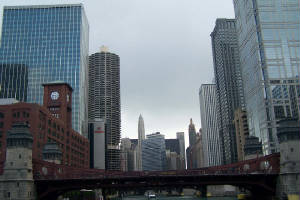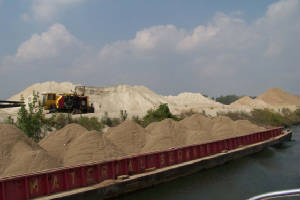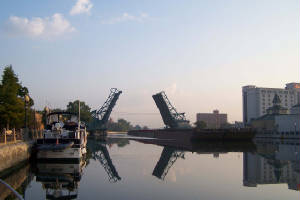|
|
 |
This section has two pages. Click the link below or at the bottom of this page to continue to Page 2.
Click here to continue to Page 2.
|
 |
|

|
| Site of son Matt and Bridget's wedding reception, seen from the Canal |
September 8 Chicago to Joliet
41.5 miles
When we left our slip at DuSable Marina, the clouds were hanging so low in the sky we couldn't see the white
spire on the top of the Sears Tower. With our bimini down and all our electronics up top on the flybridge, we hoped
we wouldn't get surprised by rain, but we had a plastic bag for the computer at the ready, just in case. By the end
of the day after the sun had been beating down on us relentlessly for hours and the temperatures had reached the mid-90s,
we would be wishing that rain had fallen.
We traveled through Chicago on the Sanitary and Ship Canal. Construction of the canal began on "Shovel
Day," September 3, 1892, and the canal was officially completed and mission accomplished on January 2, 1900 -- the day the
Chicago River water flow was reversed, so that instead of carrying the city's human and industrial waste into Lake Michigan,
it carried the waste south to pollute the Illinois and Mississippi Rivers instead. The canal also facilitated shipping
traffic from Lake Michigan to the inland rivers.
The Chicago Harbor Lock is the key to controlling the flow -- keeping the river from flowing into the lake
and keeping rising lake waters from affecting the river level. We entered the lock at 9 a.m., with We Be Blest,
whom we met in Manistee, and then were delighted to see fellow Loopers Rosetta and Classy Lady following
behind. We last saw Rosetta in Penetanguishene, and Classy Lady way back in Waterford, New York, when
they took the Erie Canal and we took the Champlain.

The lock took us down two feet, and our fantastic voyage through the heart of Chicago began. The banks
of the canal were lined with flower boxes, parks and paths, fountains, sculptures, and the opulent landscaping of riverside
condos and office buildings.
Without our bimini above, we had unimpeded views of skyscrapers rising high above us on either side.
The elaborate carved stone work of the buildings constructed in the first half of the twentieth century contrasted with the
angled glass and steel buildings of more recent vintage. We couldn't take enough pictures.
The many bridges we passed beneath were also interesting, of varied construction we could examine in detail
from below. Most of the Chicago bridges had architectural statements at each end -- stone sculptures, obelisks, spires
or gateposts. The bridge houses were a study in themselves, designed to complement the styles of each bridge's architectural
elements. Most were constructed of stone or metal, with elaborate carvings or ornate wrought trim details.
Throughout Chicago, the water in the canal was clear and turquoise. It wouldn't remain so as we continued
on our way downriver.

|
| Chicago sand dunes |
Less than an hour after leaving the Chicago Lock, we passed under an Amtrak bridge, and officially entered
the industrial zone of the river. A massive bucket loader was unloading gravel from barges and loading it on a
line of trucks. Its bucket was so big that just a couple scoops filled each truck. Right across the river was a yard full
of industrial crane and bulldozer parts and heavy construction equipment.
Sand dunes to rival the dunes of Lake Michigan stretched as far as we could see at one point. Come to think
if it, they were probably transplanted here from Lake Michigan.
There were lots of scrap metal yards with "jaws" loaders transferring rusty rubble onto barges. In
one spot we saw a machine that took a crushed car in one end and spit tinsel out the other.
Flammable liquid storage tanks of all sorts, refinery operations, power plants, a spider's web of transmission
lines strung on high towers -- it's no wonder there were six Chicago Police boats examining us carefully as we entered the
Canal. This is a terrorist's wonderland.
And the smells. Just after the smell of creosote near a petroleum tank operation cleared out
our sinuses, we passed a "Metropolitan Water Reclamation Station," and were assaulted with the unmistakable aroma of sewage.
Evidently the water was not fully reclaimed there. Observation: the water here is no longer turquoise. Not even
close.
Amazingly enough, all along the Canal, no matter how noisy or gritty the industry along the shore, we could
see great blue herons wading in the shallows, and kingfishers flying across on the hunt.
Clearly, we are finally back to cruising grounds where the journey is as interesting as the destination.

|
| View from the Joliet free dock |
We tied up at a free dock with free power in Joliet's Bicentenniel Park. Shortly after we got there,while
we were catching up on the news from Gay and Gail on Classy Lady, five police cars drove up, and scattered about to search
the park, then stop over to reassure us they would patrol the park until 10, and if we needed them after that, we could just
call, and they would be over in thirty seconds, since their station was just across the river. It seems there was a
little problem last night, but don't worry, everything is under control. We padlocked our boat to the wall, went out to dinner
with Rosetta early, and stayed aboard after dark. No problem.
The wall where we tied up is along a narrow part of the Des Plaines River between two bridges. Sirens
on the bridges announced their rising for the approach of tows with barges. We watched in fascination as the towboat
captains maneuvered their loads through the bridges, using searchlights to illuminate the bridge supports they had to thread
the barges between. Upbound tows had to get their loads through the second bridge while turning them to make a bend
in the river. We were glad our cruising guide had warned us not to tie up above that bridge. No one gets
hit there, but watching the barges come at you when you can't see the tow, and you aren't sure he can see you can be a little
disconcerting.
The tows run 24/7, and we could hear the bridge sirens and feel the gentle rock of our boat in the wakes
from the tows every once in a while all night long.
Click here to continue downriver.
|
 |
|
|
 |
|
|
 |
|
|
|
|
|
|
 |

